How Many Square Meters Does Your Indoor Playground Need? A Complete Guide
When you establish an indoor playground, one of your first worries is how many square meters you will need. The size of your indoor playground area affects safety, enjoyment, and profitability. A small space could make it feel crowded and limit the kind of activities you can offer. But a building that is too big can increase costs without providing any benefits. Knowing how much space is needed is essential for designing an appropriate indoor play area. By the end of this article, you will know exactly how to measure the right indoor play area size, whether your goal is to create a soft play area, a trampoline park, or a rigorous ninja course.
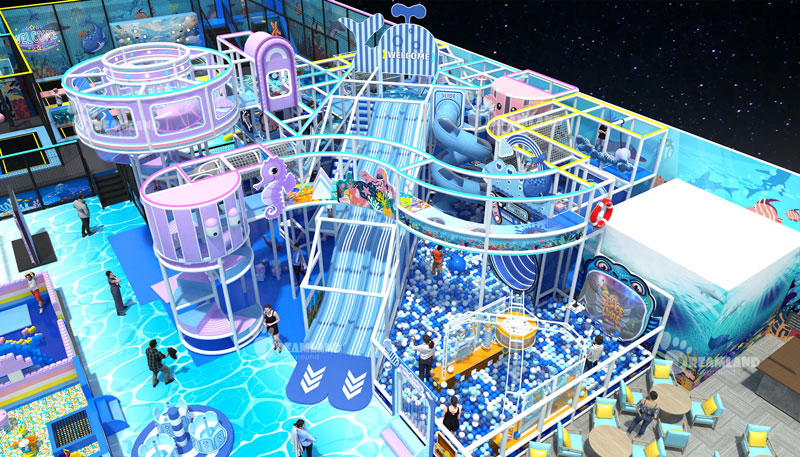
Why Size Matters for Indoor Playgrounds
When you think of designing an indoor play area, you might picture bright colors, slides, or a big trampoline park with kids laughing and having a good time. Perhaps the most important consideration is the indoor playground area's size. Everything is impacted by your choice of square meters, including the amount of space you require for your play area, trade show, and even client happiness.
1. Safety Comes First
First of all, in addition to being unpleasant, a packed and crowded playground can be dangerous. If your indoor play area is too small for the number of kids, there is a risk of accidents, injuries, or kids becoming lost. By precisely measuring the play area, you can make sure that there is enough safe space around climbing walls, trampolines, and slides. Knowing that their children have an adequate, safe room to play makes parents feel more at peace.
2. The Play Experience
Children thrive when allowed the opportunity to explore. Children may feel cramped or quickly become bored if your indoor play space is too small. However, when children have access to a good indoor play environment with enough space for running, climbing, and relaxing, they may play for longer periods of time and return more often. Simply having more space does not automatically translate into better equipment. It entails having well-designed play spaces that give kids a variety of choices and opportunities to develop.
3. Smooth Business Operations
Fair play is not the only thing impacted by the proper square footage. You will not be able to host birthday parties, group activities, or features like a ninja course or a little kids' zone if your playground is too small. On the other side, you will not gain from renting a larger office than you require and will have to spend more for workers, heating, and rent. Having a well-designed indoor play space facilitates the smooth operation of your company.
4. Customer Comfort
Keep in mind that your clients are the parents as well as the children. Adults require comfortable seating, a wide selection of food and beverages, or a decent view to keep an eye on their children. If your indoor play space is too small, it will be difficult to accommodate these essential amenities. Families are more likely to stay longer, spend more money, and visit more frequently when the play area is large and well-kept.
5. Long-Term Flexibility
The size of your indoor play space should be ideal for fostering your growth and development. A trampoline area, ninja course equipment, or even a climbing wall could be added to the playground once you have started with soft play equipment. You will not have any restrictions later if you pick the correct area now.

Factors Influencing the Size of Your Indoor Playground
When constructing an indoor play area, the manner in which you use the space is more crucial than the size of the room. Numerous crucial factors affect how much space you require for your play area and assist you in determining the final size of your indoor play area. It would be simpler to plan an indoor play area if you are aware of these variables.
1. Age Groups You Want to Serve
The various methods that kids of different ages play should be taken into account when designing an indoor play space.
- Young toddlers (ages 1-3) require small, safe areas with soft floors, small slides, and soft toys. Even though they frequently need less room, they nevertheless need to be kept apart from the bigger kids.
- Young children (ages 4–7) need a greater range of activities, including tunnels, rope bridges, climbing nets, and fun games. They should have a large area with lots of enjoyable activities.
- Younger kids (ages 8 to 12) are drawn to more exhilarating activities like ninja courses, trampolines, and climbing walls. More room is needed for these to grow securely.
If you plan to serve all age groups, you will need a larger indoor play area with more different elements than an office designated for small children.
2. Types of Activities and Play Areas
The attractions you select have a direct impact on how much space you need. Young children and toddlers will love this soft play equipment, which also fits nicely in small areas.
A trampoline requires a large, open area with safety space on both sides. Ninja courses require large areas for running, rope swings, and obstacle climbing. Climbing wall play areas need high ceilings and special, safe flooring. The size of your indoor play space should match the variety of games and activities you select.
3. Playground Equipment Layout
The way your play space is set up might have a significant impact on how much square footage you need. Multi-level designs with concealed play areas that utilize extra ground space allow kids to explore both up and below.
Because of poorly designed layouts that squander space or create traffic bottlenecks, even vast play areas can feel small and claustrophobic. In a well-designed indoor play area, people can move freely and utilize every square meter effectively. A thoughtful design not only creates more fun but also makes the most of your play area and saves money.
4. Supporting Facilities
Families, not just kids, are the target audience for play places. When determining how much room you will need for your play area, bear the following in mind:
- Places for parents and caregivers to sit
- Locations for parties and get-togethers
- Snack bars or cafeterias that provide food and drinks
- Storage areas for cleaning supplies and equipment
- Secure areas and restrooms
Even if your play areas are small, these extra conveniences can take up a significant amount of space when calculating.
5. Business Model and Location
Your play area concept will determine how much space you need. A small indoor play area in a shopping mall might just need 200 to 400 square meters.It may take 1,500 to 3,000 square meters to accommodate a larger family entertainment center (FEC) with sports fields, climbing walls, and trampoline parks. If you live in an expensive neighborhood with high rents, a smaller but well-designed playground can be a better choice. As you expand your indoor play area, you should always consider what the community wants and how much you can spend.
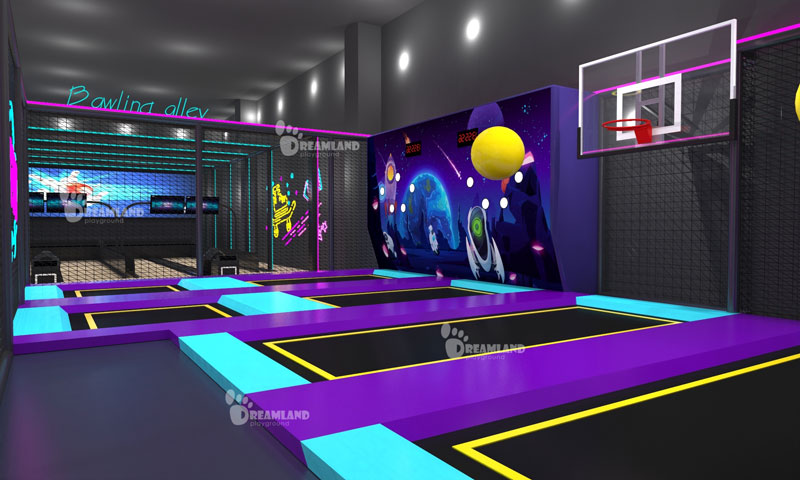
Space Requirements for Different Types of Indoor Playgrounds
Soft Play Area Equipment
Young children benefit greatly from soft play areas, which need 100 to 400 square meters, depending on the number of children present. The soft climbing frames, ball pits, and slides in these areas were all designed with safety in mind. A well-organized indoor play area may create a delightful environment for children in a small space.
Trampoline Park Equipment
Typically, 500–1,500 square meters are needed for a trampoline park layout. Hoping mats, foam pits, and ball loops need a lot of free space for safety. Since this type of playground attracts older kids and even adults, it is a great addition to Family Entertainment Centers (FECs).
Ninja Courses Equipment
Ninja courses need between 200 and 800 square meters of space, depending on their design. These are challenging and entertaining sports. Space planning for indoor play zones
is necessary for climbing walls, rope swings, and adjustable bars. Your playground will become more popular and keep kids active if you add a ninja course.
Climbing Walls Equipment
For safety, climbing dividers need higher ceilings and more durable flooring, but they take up less floor space—between 50 and 200 square meters. They are popular with older kids and high school students because they offer a skill-based challenge. This interest is well-suited for indoor play areas.
Multi-Activity Playgrounds Equipment
Multi-activity play spaces are a lot of fun for families. They offer a range of play areas and are between 1,000 and 3,000 square meters in size. By offering fun activities like light play, trampolines, ninja courses, and climbing walls, you can entertain people of all ages in one location.
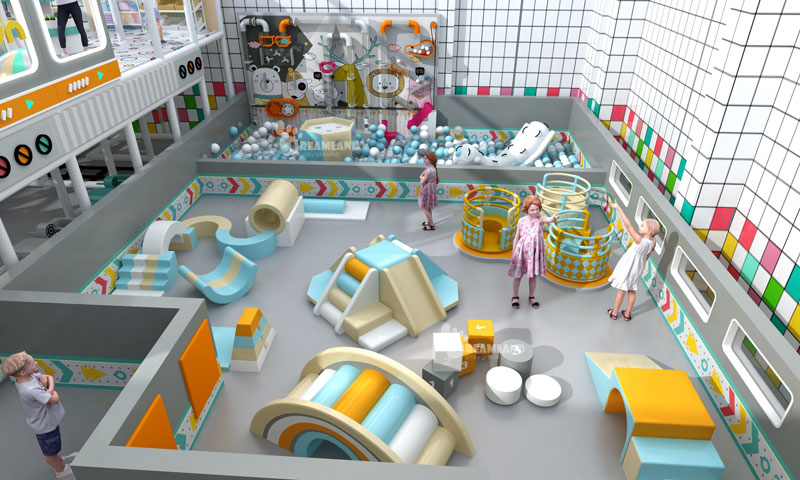
How to Maximize Your Indoor Playground Space
No matter how much space you have, a well-designed indoor play area design may turn a modest setup into a fun and useful play area.
1. Use Vertical Space Wisely
Instead of arranging all of your toys on the floor, think about stacking them with some private indoor playground equipment. Multi-level play structures allow you to fit tunnels, slides, and climbing nets into a smaller space. A three-story tower provides three times as much area for movement as a one-story configuration, yet uses the same amount of space. By piling things on top of each other, you may make additional room on the floor for different fun activities, like trampolines or a ninja course.
2. Create Age-Appropriate Zones
Zoning must be carefully taken into account when designing a lovely play area. When your indoor play area is separated into sections for various age groups, activities go more smoothly, and everyone is kept safer. A small toddler play area can be set up in a corner using soft mats and delicate play structures. Older kids can have their own space with more exciting elements like trampolines, climbing walls, and rope courses. This makes the playground safer and ensures that everyone, regardless of age, loves it.
3. Combine Activities into Compact Layouts
Using small formats can help you make the most of your available space. Instead of keeping each hobby separate, think about how you could mix activities in one place. For example, tunnels can go under climbing nets, ball pits can be connected to slides, and smart outdoor playground equipment can be installed in multi-story buildings. These creative playground designs make effective use of the existing space while emphasizing enjoyment.
4. Plan Support Areas Strategically
Support zones are important when choosing the size of your playground, even if they do not need to take up a lot of play area. You can maintain the center of the room clear for active play while still enabling parents to watch what is happening by placing seats along the walls. While lesser areas can be used for vending machines, lockers, or storage, the upper floors can be used for party spaces. By properly planning indoor play areas, you can achieve a balance between comfort amenities and play areas.
5. Keep Safety in Mind
Never sacrifice safety in an effort to make the most of the space in your play area. When items are positioned too close to trampolines, climbing walls, or slides, accidents may happen. A well-designed indoor play area not only lowers the chance of accidents but also provides kids a sense of openness and lets them move about without running into anything. Playing in a secure environment is always enjoyable.
6. Use Professional Playground Planning Tools
Finally, when creating an indoor play area, think about the future. Allow for flexibility so that you can grow or improve.
You may want to start with soft play equipment, but later on, you may want to add a trampoline area, a new ninja course, or even elements from a sports field. If you plan your playground with future improvements in mind, it will continue to be interesting and exciting for many years to come.
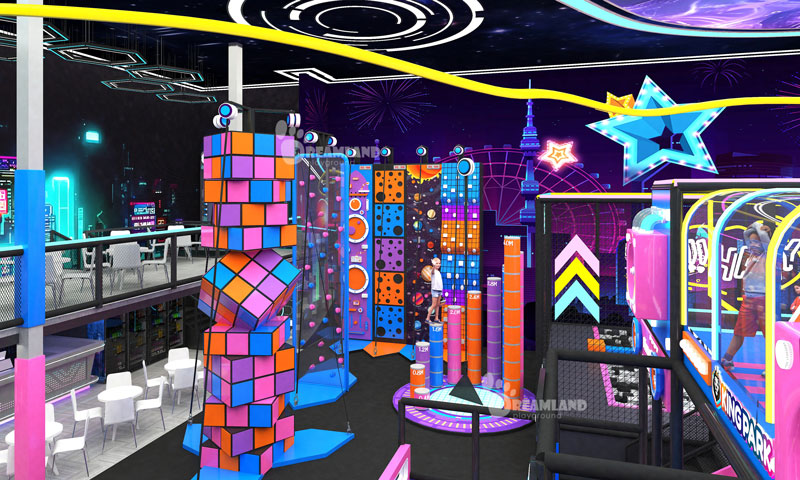
Choosing the Right Size for Your Indoor Playground
When deciding the size of an indoor play area, it is just as vital to have a location that is safe, interesting, and beneficial for play as it is to have enough space. Enough space for play spaces guarantees that kids can have fun without feeling crowded, parents can relax, and everything runs smoothly. Planning your interior space well is essential, whether you are creating a large family fun center, a trampoline park, or a pleasant place for kids to play.
By designing your play area carefully, you can make sure that every part of your space is exciting, safe, and useful. Our primary objective at Dramland Playground is to transform empty spaces into amazing play environments to meet your playground space requirements. We help you maximize your investment by accurately measuring your play area and creating engaging indoor play environments.
Whether you want to start with simple indoor playground equipment or evolve into a full-scale ninja course or sports arena attractions, our staff can help you make the most of your play space while planning for a future commercial indoor playground. With Dreamland Playground’s help, you do not just pick the perfect size—you also create a fun area that appeals to families and lets your business grow.
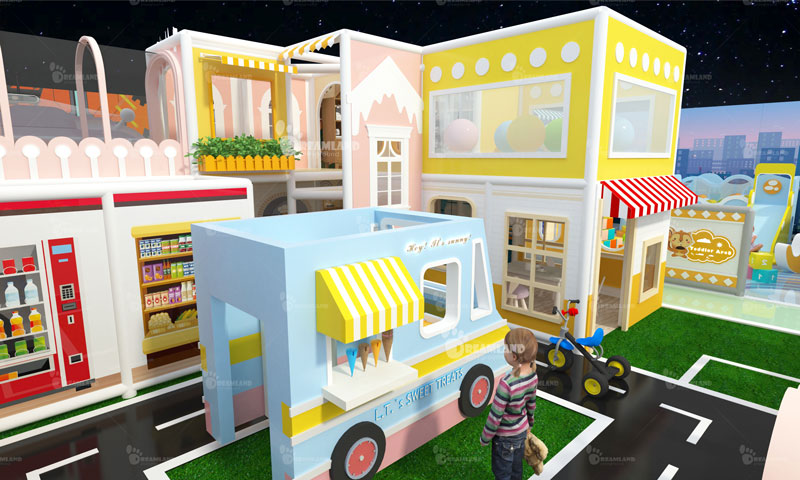
Conclusion
Creating your own concept should always be the first step in creating an amazing indoor playground size guide. Choosing the right space for your indoor playground is the most important part of the indoor playground planning and design process since it affects future profitability, customer satisfaction, and safety. Take into account how much space each play area needs, then modify it to fit the goals of your business. This will help to make the area safe, functional, and active.. Not just for installing equipment, precise measurements are necessary to guarantee your playground will be profitable and enjoyable for years to come.






